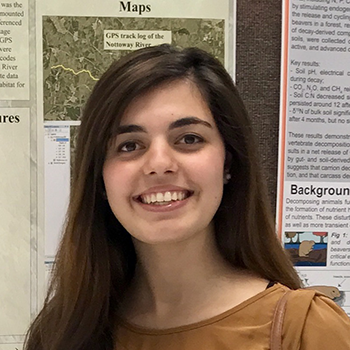
Ph.D. student Emine Fidan was chosen as a 2019-2020 NASA/NC Space Grant Graduate Research Fellow. Her research project is titled, “Using Machine Learning and Remotely Sensed Data to Develop Spatiotemporal Maps of Flood Surge and Retreat.”
These students represent 11 North Carolina universities across the state and will be researching a wide range of science, technology, engineering, and mathematics (STEM) disciplines pertinent to the aerospace and aviation fields.
From machine learning in aerospace engineering to new sensors to monitor lightning strikes on aircraft to meeting the dietary needs of astronauts, the diverse Undergraduate Research Scholars’ projects will engage the future STEM workforce in basic or applied aerospace-related research projects. The research process will also facilitate the development of mentor relationships between students, faculty and the NASA community. The Graduate Research Fellows will explore questions ranging from what remotely sensed satellite data can tell us about hurricane and floodwater impacts on our planet, to what new materials can be investigated for use in astronaut suits, as we travel farther and farther beyond our planet. These future explorers will participate in active, in-depth research activities in aerospace and aviation, science and technology.
Learn more about Emine and the other fellows here.
What got you interested in this work?
I moved to North Carolina the beginning of August 2018 and within a month Hurricane Florence made landfall. I had never seen the impacts of a natural disaster within my circle. I was curious to understand how flood hydrology behaves during a hurricane and what the influencers of inundation are within the coastal plain. Never before has an inundation model been developed using dynamic socio-environmental predictors coupled with machine learning techniques; thus, my goal is to use my background in biosystems engineering and data analytics to develop a machine learning model that will provide knowledge on flood zones and characteristics of flooded areas.
Explain a little about your project.
The North Carolina Space Grant Graduate Research Fellowship is funding my research on the development of a spatiotemporal flood map model for North Carolina during Hurricane Florence. This model will utilize satellite imagery to highlight inundation and geospatial data to capture characteristics of areas that flood. The satellite imagery depicting flooding serves as a source of training data, while the geospatial data act as predictor variables in the development of a predictive model. Then, a machine learning algorithm will be trained to spatially predict flood extent over time as a function of these different variables. The use of both static and dynamic geospatial data allow for the reconstruction of a flooding timeline, in which sub-daily flood maps can be created based solely on the input of the geospatial data. The result is a high-resolution spatio-temporal flood map depicting large-scale inundation.
What question or challenge were you setting out to address when you started this work?
By exploring the literature, it was observed that no study has developed spatiotemporal flood maps by coupling dynamic variables, machine learning, and socio-environmental predictors to understand the flooding process after a hurricane. Thus, the goals of this study are to develop a methodology in which geospatial data coupled with machine learning techniques can be utilized to create spatiotemporal flood maps, understand the rapid flood process after a hurricane by creating a time-series, and distinguish the characteristics of areas that experience heavy inundation during natural disasters.
What is the importance of this research?
A billion dollars are being allocated to rebuilding infrastructure lost during Hurricane Florence. Research needs to be conducted on the flooded areas and the associated socio-environmental characteristics to better understand the flooding process and the areas prone to hazard. Thus, with the development of flood maps, one can observe the surge and retreat of flood waters and the characteristics of areas that are in danger of future flooding. The end goal is to provide citizens, emergency responders, and natural resource managers with information on flood hazard zones and potential flood risk areas.
What do you hope to accomplish through this research?
My goal is to play a role in monitoring and sustaining our natural environment using not only using my skills in environmental engineering, but also modeling and data analytics. The advancement of technology and sustainability geared toward our environmental systems is an application that will be benefited globally. Throughout this project, I will be working with young females and outreaching to students interested in STEM in the hopes of inspiring the younger generation to be innovative thinkers who push boundaries.
